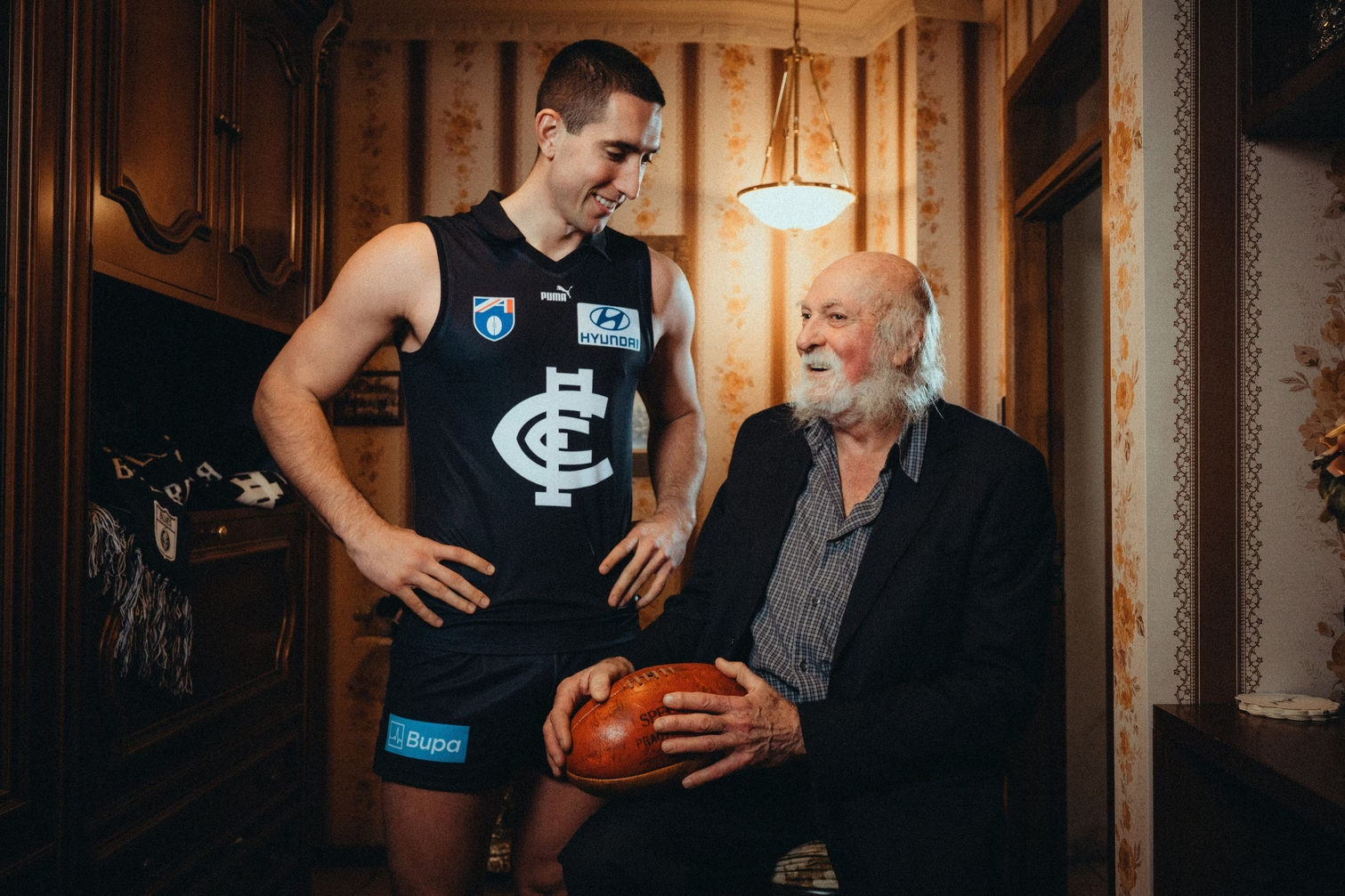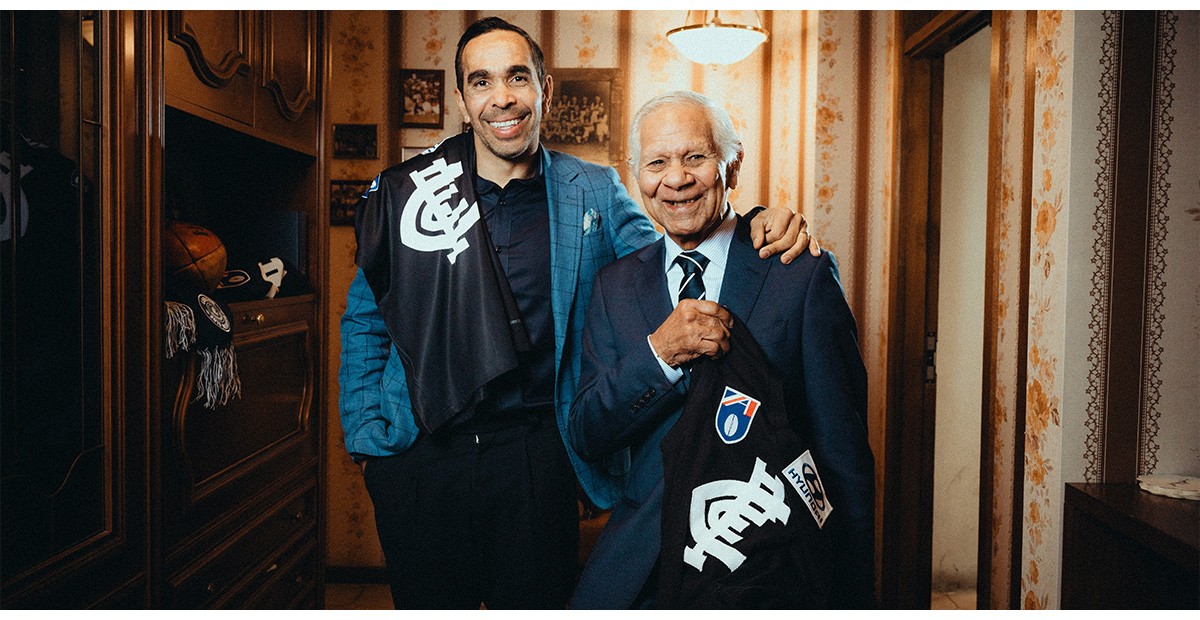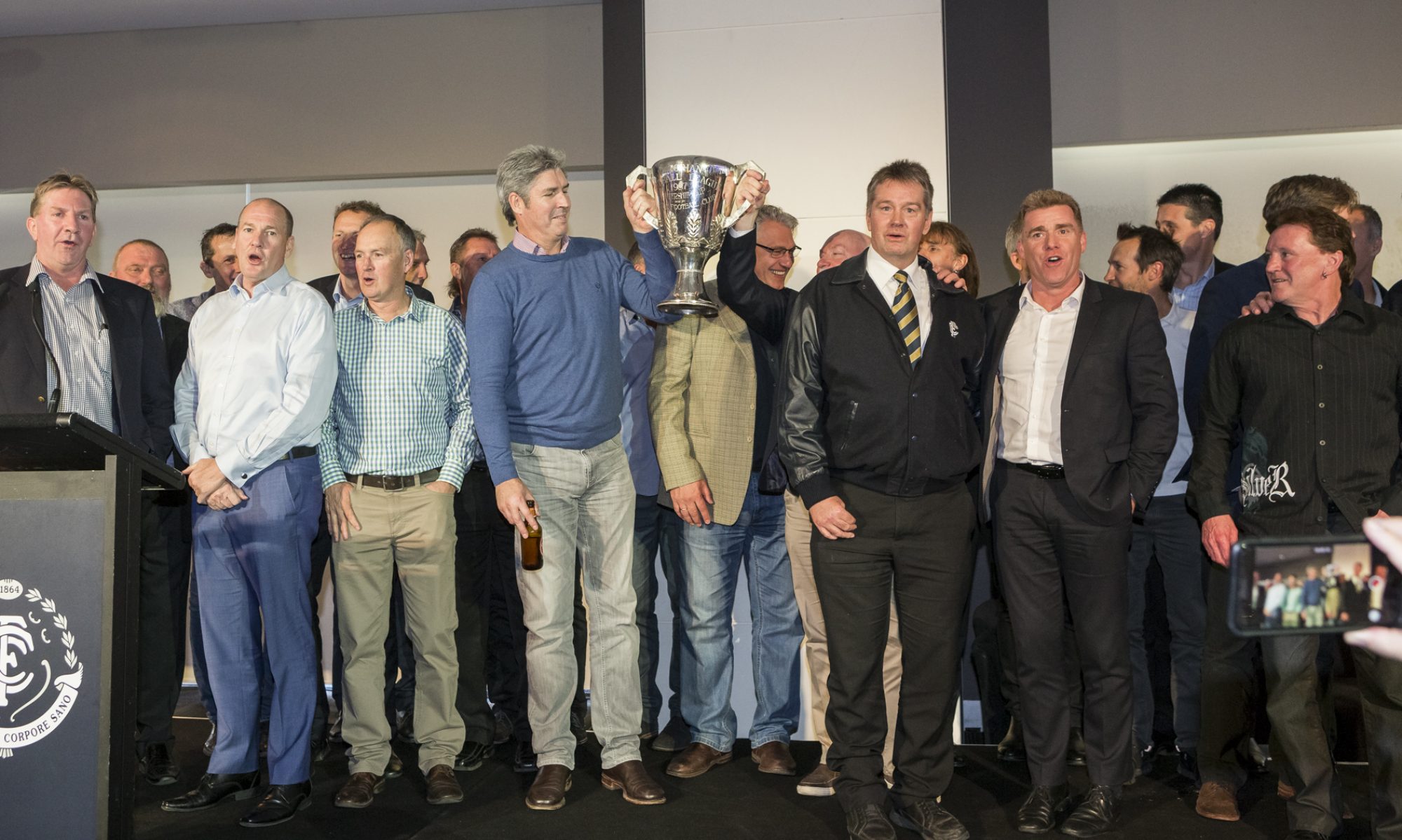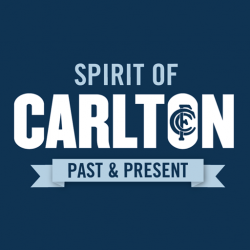Riley Beveridge gives readers a peek inside as Carlton champions past and present gather to celebrate the Club’s 160th year.
By Riley Beveridge for afl.com.au

OUTSIDE, in the bustling heart of Lygon St, a middle-aged man in a Carlton beanie peers through the window of an old school Italian restaurant. Almost instantly, his eyes seemingly pop out of his head.
From the outside, you could sense commotion happening within. But on a drizzly Tuesday morning in the middle of winter, no pedestrian – especially not one wearing a Blues bobble hat – could have anticipated what was actually going on inside.
There stands legends of the football club he is proudly representing. Anthony Koutoufides is holding court with Charlie Curnow, Craig Bradley is exchanging tips with Sam Walsh, Syd Jackson is laughing with Patrick Cripps.
Jacob Weitering is sharing a coffee with Bruce Doull, Sam Docherty is lamenting the weather with Ken Hunter, while Eddie Betts is describing a couple of his best goals to an audience of Jesse Motlop and Lachie Fogarty.
To the Carlton fan outside, the scene must have felt like a dream. But, as AFL.com.au experienced, the occasion was the culmination of months spent planning and preparing for the club’s 160th birthday celebrations.

Jacob Weitering is the first one to pull the strip out of a Carlton shopping bag.
The navy blue heritage guernsey, set to be debuted against Hawthorn in round 22 to celebrate the famous club’s 160th birthday, encompasses several eras of the club’s rich and successful history.
It’s marked by a popped collar and the vintage AFL logo of the ’90s. Even the club’s major sponsors, Puma and Hyundai, have bought into the fun and altered their logos to the looks of yesteryear.
“When you first arrive at Carlton as a player, it’s hard not to hear about the incredible history. You see not only the cups when you walk in, but the memorabilia of past players, from Norm Smiths to boots and jumpers,” Weitering says.
“We are a big club with a storied history, so to have some of the champions of the game come back and be involved with the club and something like this, it’s great. The guernsey looks fantastic. It’s going to be great to run out in a collared shirt, I know all the boys are pretty excited about it.”
Weitering holds the jumper up and admires its features. But his attentions are immediately diverted elsewhere, as David ‘Swan’ McKay wants a chat. The duo has been paired together on what is a unique day for the football club.

Weitering on meeting Doull, Heritage guernsey
Key defender Jacob Weitering joined Carlton Media for a chat at the Club’s Heritage guernsey launch.
As part of the birthday bash, Carlton has spent months partnering past and present players to celebrate the history of a club that has won a joint-high 16 V/AFL premierships.
Three members of the last flag-winning team – Anthony Koutoufides, Craig Bradley and Dean Rice – are in attendance, joined by Hall of Famers like Ken Hunter and Bruce Doull, premiership stars like McKay and Syd Jackson, as well as more recent club greats such as Matthew Kreuzer and Eddie Betts.
There is Blues memorabilia stacked everywhere around Johnny, Vince and Sam’s Ristorante in the beating heart of Carlton’s Lygon St and, on various occasions across the morning, the old film photographs and vintage VFL records are perused by the likes of Adam Cerra, Tom De Koning and Matt Kennedy.
Players, both past and present, are whisked away at random times to partake in a photoshoot displaying the fresh jumper. Each time a new group is asked to step into the back room, a different quip inevitably rings out from a former teammate.
“Looking sharp,” Carlton’s current skipper, Patrick Cripps, says to Koutoufides. The topic of that conversation quickly turns to Cripps’ dominance in 2024, the type that is reminiscient of Koutoufides way back in 2000.
Just metres away, Charlie Curnow is enthusiastically pumping the tyres of his former teammate Betts and his recent goalkicking exploits in the country leagues with Wangaratta Rovers.
Much of the organisation for the day’s event owes to the work of the club’s long-time administrator Shane O’Sullivan and the Spirit of Carlton association he’s heavily involved in, a group whose mission statement is to “bring together past players and officials” with the current crop to “renew and build the Carlton spirit”.
O’Sullivan’s work is evident throughout the morning. Past players have been asked to gather at 10am for a coffee, with current Blues players arriving around an hour later after a light session at Ikon Park earlier in the morning. As each of the current crop arrives, the respect they show to the club legends around them is noticeable.
Each player takes the time and care to renew acquaintances with every Carlton great in attendance. Even if it means delaying their scheduled photoshoot for a couple of minutes, no conversation is ever halted.
The morning almost has the feel of a reunion and that’s because, for most of the players involved, it is. Of course, the older players have spent decades in each other’s company. But the new guys are just as familiar with those who have worn the navy blue jumper before them, owing much to O’Sullivan’s work.
“We’ve been fortunate enough to have a lot of the club legends come through in the past and we look up to a lot of these guys,” Walsh tells AFL.com.au. “It’s pretty cool for the club to celebrate its history like this.”
There are hugs, laughs, war stories and even a few tips shared. Lachie Fogarty, in particular, spends much of the morning in the presence of Betts, eager to absorb any lessons that the 640-goal champion – and his former teammate – might be willing to share.

Carlton’s current crop would have been silly not to soak it all in. After all, there were seven premiership players and 17 V/AFL flags worth of experience in the room. But more would arrive shortly.
With the festivities starting to wrap up around lunchtime, in came a few surprise late arrivals. Unbeknownst to many in the room, Jackson had decided to follow the morning with a meal to celebrate his 80th birthday, opting to dine at the same restaurant the event had been held at.
And so, in walked a series of Carlton’s premiership greats of the 1970s – Geoff Southby, Percy Jones and Robert Walls among them – to celebrate their great mate. It was a slightly crazy and unexpected, though fitting way to end the morning.
You can celebrate with us early by joining the Spirit of Carlton Committee and past players at the annual Spirit of Carlton Luncheon on Friday 9 August. Purchase your ticket here.
But a more fitting way to celebrate Carlton’s 160th birthday celebrations, and to celebrate a season that has already promised so much, would be for the current crop of Blues players to add another premiership to the collection later this year. For Walsh, that remains the ultimate goal.
“That’s the motivation for all of us,” he says, admiring the photos of Carlton’s premiership teams of the past.
“‘Braddles’ was saying before, you go through ups and downs and you can’t look too far ahead. We want to be known as that sort of really tough, gritty team. You see the collars we’ll wear in this game and you want to be known as hard workers. We know we’ve got a lot of guys who are wanting the same thing.”























